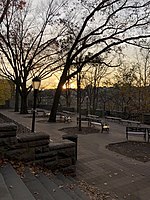Mother Cabrini High School

Mother Cabrini High School (MCHS) was a Catholic high school located at 701 Fort Washington Avenue between Fort Tryon Park and West 190th Street, with a facade on Cabrini Boulevard, in the Hudson Heights neighborhood of Washington Heights in Upper Manhattan, New York City. The school was established as "Sacred Heart Villa" in 1899 by Frances Xavier Cabrini (1850–1917) and was sponsored by the Missionary Sisters of the Sacred Heart of Jesus, the order she founded. It offered specialized and distinctive programs of study to enhance the education of its students, all female. The name was changed to Mother Cabrini High School when the current main building opened in 1930.The school drew its students from "all over New York City and Westchester, with a large concentration of students from Manhattan and the Bronx." Through much of its history, the student body was largely the children of Irish and Italian immigrants, but by the time of its closure in 2014, the school was predominantly Latino, primarily from the Dominican Republic.In January 2014, the school announced that it would close at the end of the school year.From 1933 to 1959, the body of Mother Cabrini laid in repose in the school's chapel, until it was moved to the Cabrini Shrine that was built next to the high school.
Excerpt from the Wikipedia article Mother Cabrini High School (License: CC BY-SA 3.0, Authors, Images).Mother Cabrini High School
Fort Washington Avenue, New York Manhattan
Geographical coordinates (GPS) Address Nearby Places Show on map
Geographical coordinates (GPS)
| Latitude | Longitude |
|---|---|
| N 40.857888888889 ° | E -73.935555555556 ° |
Address
Success Academy
Fort Washington Avenue 701
10040 New York, Manhattan
New York, United States
Open on Google Maps










